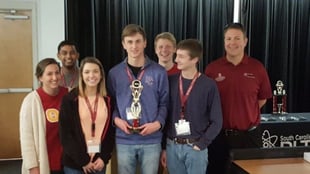Carl Conrad is an Introduction to Engineering Design (IED) Master Teacher who is certified in math and English. Carl is a teacher and head tennis coach at Dover High School in Dover, Ohio. Carl’s hobbies include classical guitar, woodworking, woodcarving, fishing, homebrewing, and golf.
I would like to share my experience in implementing the new Introduction to Engineering Design (IED) Automata Design Challenge in my classroom.
In September 2016, I decided to try the Automata Design Challenge pilot, which took me on a journey toward presenting a session on automata fabrication at the PLTW Summit with fellow Master Teacher Bill Small. It was a process that led me to the following conclusions:
1. The Automata Design Challenge is a true engineering project. The designs modeled on Autodesk Inventor do not always function without modifications, tinkering, or redesign.
2. This project allows for a great deal of creativity and differentiation. The automata toy can be as simple or as complex as a student wants it to be.
3. The Automata Design Challenge puts the “Project” in PLTW.
Over the past year, I have grown to love this project! But … it didn’t start out that way.
I found out in spring 2016 that the beloved Puzzle Cube Project was being replaced by the Automata Design Challenge. This was like losing a loved one, and I began going through the stages of grief: denial, anger, bargaining, depression, and acceptance. At first, I was so angry and frustrated that I even considered not continuing as a Master Teacher.
I decided to pilot the new project with my IED students. Immediately, we ran into problems. I sent a lengthy email to our IED curriculum team. The response that I received surprised me: I was challenged to foster in my students an “Engineering Mindset”: They needed to redesign, tinker, and problems solve – and make their automata function.
I needed to change my mindset. I needed to figure out how to make this project work.
There were about 15 teachers across the country who piloted the project and met through five video conference feedback sessions. There was open dialogue and the exchange of ideas about how best to set up our teachers and students for success on this project. Many revisions were made to the pilot that has transformed it into the project that exists now. And in the spirit of continuous improvement, it is still a work in progress.
As the 2016-17 school year progressed, I worked through the Automata Design Challenge with my students. I was very pleased with the resources and videos that provided the scaffolding instruction on cam design. To implement the project, I did have access to a small woodshop and 3-D printers. Under my direction, we set up a full-class assembly line to standardize box construction and developed some “Automata Standardized Parts” that could be batch printed.
I was very excited with the ideas that my students came up with: a trumpet that matches the fingering of a major C scale, a bobblehead monster, a dragon flapping its wings. (Have you ever tried model a dragon on Inventor?)
The project is still a work in progress. After teaching an IED Core Training at Sinclair in June, I went home and revised all my “Automata Standardized Parts” in preparation for giving my presentation at PLTW Summit 2017. The Inventor parts and the documentation are available on the IED Community Forum.
Implementing this project, participating in the pilot, and giving the presentation at the Summit has been a great experience. It has helped me to grow as an educator. I also have a newfound respect for our curriculum team, which is very open to constructive feedback.
Will there be more revisions to IED coming? I certainly hope so. I would like to see MORE projects, and I envision a course wherein the mathematics and scaffolding lessons fade into the background because they are integral to the completion of the project. If you have ideas for additional projects not currently in the curriculum, for the sake of our students, please share them with the rest of us!
PLTW’s blog is intended to serve as a forum for ideas and perspectives from across our network. The opinions expressed are those of each guest author.


